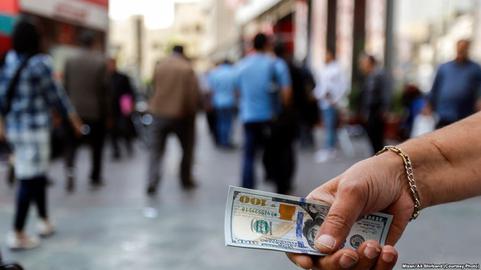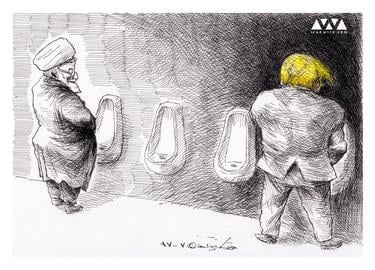As President Hassan Rouhani addressed the United Nations General Assembly in New York City on Monday, September 24, Iran’s national currency continued its free fall, as it has been doing for the last several months —and more dramatically since President Trump’s announcement in May that the US was abandoning the nuclear deal.
By Wednesday, September 26, it passed 160,000 rials (IRR) per US dollar, reaching 170,000 rials to the dollar, and later in the day rose close to 200,000. Rouhani’s opponents at home and abroad were quick to point out — once again — that his administration had failed to tame Iran's currency market.
Why does the Iranian government continuously fail to control the market? For many, this would mean keeping the currency exchange rate constant, and it does not matter how much hard currency the government has allocated to importing necessities and essential products — it matters how much it costs to buy a $10, $20 or $100 banknote. There’s a notable rift between the Iranian government’s perception of hard currencies and the Iranian people’s understanding of it. For the government, dollars, euros, pounds and yuans are instruments of trade, tools Iran needs to import commodities. But for the people, they are monetary instruments and assets used to manage their portfolios, a means of staving off future uncertainty. The government wants to preserve its reserves to be able to conduct trade with international markets. But the people want to buy hard currency in order to save.
Policy makers believe they can control the market by withholding the Central Bank's reserves, freezing exchange rates at an artificially low rate and creating a labyrinth of bureaucratic work to distribute much-desired and much-needed hard currency. They believed that this policy would keep the prices of commodities and goods constant. In other words, the Iranian government created chaos and havoc in the currency market to retain the commodity market. And this trade-off has not worked at all. Instead, the Rouhani administration's policies have inflamed the demand for hard currency, frustrated businesses and frightened consumers.
“They Won’t Listen”
Kaveh is a small-time importer who brings in food items from China. His assessment is simple: "There is no dollar in the market.” He and his colleagues cannot even buy Chinese yuan in the secondary market. When they do succeed in securing a trade, the deal is not done until they meet the exporter, who pays with yuan and therefore pays a little bit extra. "No exporter will sell his hard currency or foreign currency for anything less than the street rate,” Kaveh says. Here he is referring to Iran's free currency market, where people buy cash and money orders. He spends a lot of time in exchange offices and government buildings trying to track down the currency he needs to continue his business. “It’s a circus. One day they have euros, another day only yuan, and some days I have to take a mix of foreign currencies and they [have to] figure out how to send it over". He feels that no one is listening to businessmen like him. The government has abandoned him and he and people like him must fend for themselves.
Members of the business community do not understand why the government has failed to take steps to address chaos in the marketplace. Conspiracy theorists and self-appointed experts crowd the social media environment — in particular, the most popular channels on Telegram, which is widely-used despite being filtered — with their opinions on government inaction. Some suggest the government has purposefully engineered the fall of the rial to pay off its debt and finance its budget. Some accuse petrochemical companies of manipulating the market to increase their profits. And of course, when people are convinced the foreign currencies will gain against the rial, they rush to buy, fulfilling all the prophecies and predictions of the rapidly-declining rial.
An Understandable Panic
Ali, who teaches economics as a part-time instructor in Tehran, says it’s not fair to blame the people for the rush on the currency markets. "Average citizens have witnessed so many calamities resulting in them losing purchasing power that one really cannot blame them for panicking,” he says. It is true that Iranians buying foreign currencies as an investment and saving has pushed rial further down, but that is not all there is to it, he says. ”Money supply has increased significantly in recent years, but the government hided it using a fixed exchange rate". When President Trump announced a new round of sanctions on Iran's economy, the markets were already vulnerable.
If the Iranian government had not decided to use a fixed exchange rate as a symbol of its economic success, an adjustment in the market would have begun two or three years ago. But at the moment it is quickly trying to re-adjust itself to increase money supply, with the sanctions as part of the package. The result is the worst currency crisis Iran has suffered . Every day, the rial falls to a new historically-low record. Those who know how to make money out of the crisis continue to flourish, with the increasing gap between the official and the market exchange rates offering too many rent-seeking opportunities for profiteers to pass up. In fact, government policies have opened up the economy to a new wave of racketeering and unethical behavior. People are at a loss as to what to do. They know their rials, of which they have many, are losing value by the hour. Their only solution is to convert their savings, and convert them quickly. The government’s policies have compromised them and their economic welfare instead of protecting them.
President Hassan Rouhani might be persuasive on the world stage, but everyone knows his economic policies are failing Iranians at home. And it’s all because he wanted to prove a point — that when it came to the dollar, he wanted to show that his government is robust enough to take on the present environment. The politicians seem to be hovering in a dream where they can defy gravity, while ordinary Iranians know the truth: that they’re heading for a downward spiral they might not be able to handle. And that is one scary image — and reality — with which to live.
visit the accountability section
In this section of Iran Wire, you can contact the officials and launch your campaign for various problems

























comments
Hello,
Could you write an article about who is fixing the free market rate of iranian rial to USD, EUR , there is that website Boonbast which inform us about the rate and then people use the rate to do exchange, but we don t know which mechanism fix the rate and who is doing it...
Thanks a lot